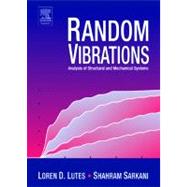
| Preface | xi | ||||
| Chapter 1 Introduction | |||||
|
1 | (2) | |||
|
3 | (4) | |||
|
7 | (1) | |||
|
8 | (3) | |||
| Chapter 2 Fundamentals of Probability and Random Variables | |||||
|
11 | (1) | |||
|
12 | (3) | |||
|
15 | (5) | |||
|
20 | (6) | |||
|
26 | (9) | |||
|
35 | (3) | |||
|
38 | (10) | |||
|
48 | (5) | |||
|
53 | (6) | |||
| Chapter 3 Expected Values of Random Variables | |||||
|
59 | (1) | |||
|
59 | (5) | |||
|
64 | (14) | |||
|
78 | (3) | |||
|
81 | (3) | |||
|
84 | (6) | |||
|
90 | (5) | |||
|
95 | (1) | |||
|
95 | (8) | |||
| Chapter 4 Analysis of Stochastic Processes | |||||
|
103 | (2) | |||
|
105 | (2) | |||
|
107 | (7) | |||
|
114 | (6) | |||
|
120 | (7) | |||
|
127 | (5) | |||
|
132 | (6) | |||
|
138 | (10) | |||
|
148 | (6) | |||
|
154 | (7) | |||
|
|||||
| Chapter 5 Time Domain Linear Vibration Analysis | |||||
|
161 | (9) | |||
|
170 | (7) | |||
|
177 | (4) | |||
|
181 | (5) | |||
|
186 | (7) | |||
|
193 | (12) | |||
|
205 | (5) | |||
|
210 | (1) | |||
|
211 | (1) | |||
|
212 | (7) | |||
| Chapter 6 Frequency Domain Analysis | |||||
|
219 | (2) | |||
|
221 | (5) | |||
|
226 | (2) | |||
|
228 | (4) | |||
|
232 | (2) | |||
|
234 | (7) | |||
|
241 | (4) | |||
|
245 | (6) | |||
|
251 | (3) | |||
|
254 | (3) | |||
|
257 | (4) | |||
| Chapter 7 Frequency, Bandwidth, and Ampitude | |||||
|
261 | (1) | |||
|
261 | (11) | |||
|
272 | (10) | |||
|
282 | (16) | |||
|
298 | (3) | |||
|
301 | (6) | |||
| Chapter 8 Matrix Analysis of Linear Systems | |||||
|
307 | (4) | |||
|
311 | (2) | |||
|
313 | (6) | |||
|
319 | (9) | |||
|
328 | (6) | |||
|
334 | (11) | |||
|
345 | (6) | |||
| Chapter 9 Direct Stochastic Analysis of Linear Systems | |||||
|
351 | (3) | |||
|
354 | (2) | |||
|
356 | (5) | |||
|
361 | (4) | |||
|
365 | (10) | |||
|
375 | (6) | |||
|
381 | (10) | |||
|
391 | (4) | |||
|
395 | (16) | |||
|
411 | (4) | |||
| Chapter 10 Introduction to Nonlinear Stochastic Vibration | |||||
|
415 | (3) | |||
|
418 | (13) | |||
|
431 | (3) | |||
|
434 | (13) | |||
|
447 | (18) | |||
|
465 | (15) | |||
|
480 | (7) | |||
| Chapter 11 Failure Analysis | |||||
|
487 | (1) | |||
|
488 | (7) | |||
|
495 | (9) | |||
|
504 | (10) | |||
|
514 | (2) | |||
|
516 | (4) | |||
|
520 | (3) | |||
|
523 | (6) | |||
|
529 | (4) | |||
|
533 | (10) | |||
|
543 | (7) | |||
|
550 | (7) | |||
| Chapter 12 Effect of Parameter Uncertainty | |||||
|
557 | (4) | |||
|
561 | (1) | |||
|
562 | (4) | |||
|
566 | (3) | |||
|
569 | (9) | |||
|
578 | (4) | |||
|
582 | (8) | |||
|
590 | (6) | |||
|
596 | (5) | |||
|
601 | (5) | |||
| Exercises | 606 | (7) | |||
| Appendix A Dirac Delta Function | 613 | (4) | |||
| Appendix B Fourier Analysis | 617 | (6) | |||
| References | 623 | (10) | |||
| Author Index | 633 | (2) | |||
| Subject Index | 635 |
The New copy of this book will include any supplemental materials advertised. Please check the title of the book to determine if it should include any access cards, study guides, lab manuals, CDs, etc.
The Used, Rental and eBook copies of this book are not guaranteed to include any supplemental materials. Typically, only the book itself is included. This is true even if the title states it includes any access cards, study guides, lab manuals, CDs, etc.